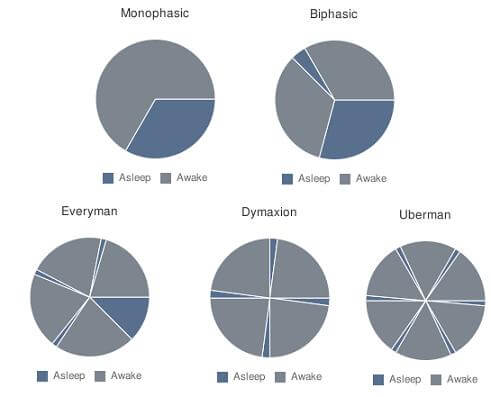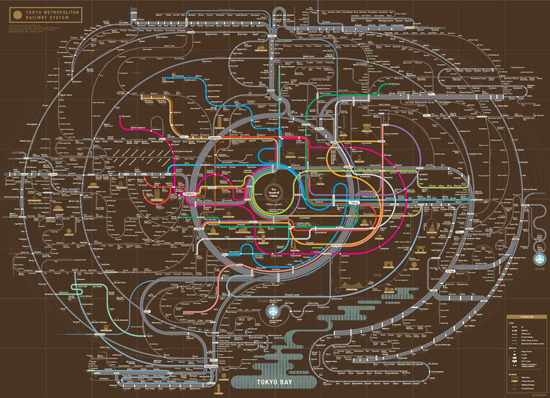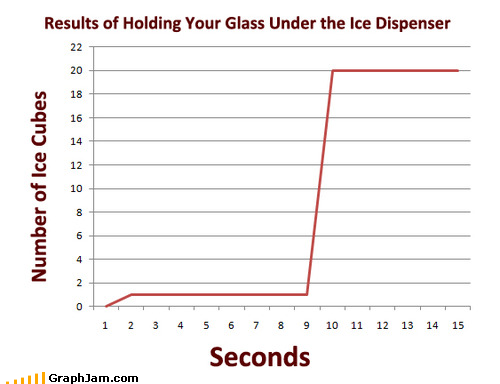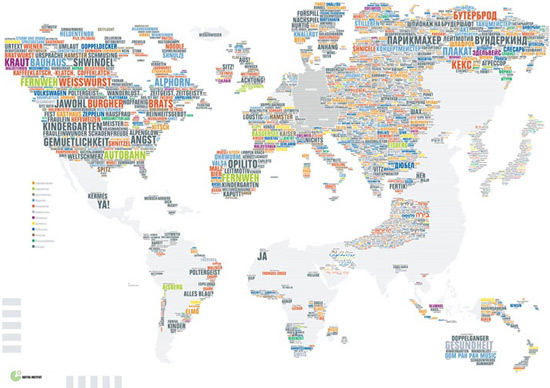- 2010_06_11_15_57_www_yapfiles_ru_files_100814_dlya_shizo.gif (GIF Image, 400×248 pixels)
- The Troubles With Modern Sleep: Myths, Memory, and Mortality
Are you getting eight hours of uninterrupted sleep every night? …Why? Though many of us consider the 8 hour (really, 7 to 9 hour) period of sleep as the ultimate way to rest, our bodies may be set up differently than we think. Natural sleep cycles tend to occur in several parts, change with the seasons, and take place partially in the day. Some people actively look to improve their sleeping habits by switching to several evenly spaced naps in a 24 hour period. Science may provide a way to get by on less sleep thanks to genetic engineering. Research at the UC San Francisco has identified a genetic mutation that allows humans, and genetically altered mice given the gene, to sleep less than their peers and still be awake and well rested. No matter how you look at it, our notions of when to sleep, how long to sleep, and why we sleep may need to be updated as we move into the future. Down a few caffeine pills, drink some warm milk, and crank up the volume on the white noise – it’s time to re-examine our confusing and conflicting ideas about sleep.
Our first main problem is that people have largely strayed from ‘natural sleep’. For the majority of living creatures on Earth, sleep is intimately connected to the Sun. Humans have tried to be an exception. The advent of widespread artificial light in the 19th century allowed us to start staying up later. In the 21st century the majority of people in industrialized countries have shifted their waking time so that it no longer directly corresponds to sunlight hours. That flexibility is what allows us to travel internationally, work in rotating shifts, and get things done. However, it could also be stunting our creativity, hurting our memory, maybe even sapping our intelligence. Here’s Jessa Gamble, a science journalist in Canada, raising her concerns about our departure from natural sleep during her presentation at TED this year:Gamble’s talk is woefully short on scientific citations (her upcoming book on the subject is likely more thorough), but I can fill in some of the gaps. First, her assertion that people naturally sleep in two segments at night (known as segmented sleep) is well supported by a landmark paper by Thomas Wehr published in the Journal of Sleep Research. Back in 1992, while at the National Institute of Mental Health, Wehr demonstrated that people put into winter-like periods of sunlight (<10 hours) would develop a biphasic sleep. Essentially they slept, woke up, and slept again. During that intermediate waking period, the body produced larger amounts of the hormone prolactin (Gamble mentions this). Prolactin is reponsible for lactation in mammals, but it has also been linked to happiness, sexual gratification, and relaxation. What’s so important about prolactin? Well it’s one of the necessary hormones for our functioning, it counters dopamine, and it might help you stay smart. Research in the journal Science and the Journal of Neuroscience show that it helps increase mental plasticity in women during pregnancy. It may be doing the same in everyone.
‘Natural sleep’ is probably not eight hours of uninterrupted sleep. In fact, a little interruption is probably good, at least in longer winter nights. Humans in short summer nights (in Wehr’s experiments) generally didn’t experience biphasic sleep. But many people will tell you the importance of getting a nap during the day, especially during the hot summer. Research in Germany has shown that even a relatively short nap (20 mintues or so) can have a pronounced effect on memory. The siesta is good for you.
So, during some times of the year your body is probably adapted to sleeping longer each night with a break in the middle. And during all or part of the year your body probably wants a nap during the day. Returning to this ‘natural sleep’ cycle seemingly has mental benefits, and those that follow such cycles may be better able to remember important information, and stay alert.
In an effort to capitalize on the segmented sleep phenomenon and to capture more awake hours during the day, some people have attempted to switch their clocks completely. They look to sleep a shorter amount of time per day (sometimes as little as two hours) and to do so in smaller chunks. This polyphasic approach to sleep has waxed and waned in popularity. YouTube and the internet at large are ripe with examples of people attempting, and generally failing, to switch to a new cycle. I don’t really want to get embroiled in the controversy about whether such sleep cycles are feasible, so I’ll pass the buck: here’s a pro-polyphasic site, and here’s one of the more popular counter arguments (with update). The following video features one of the more discussed researchers, Claudio Stampi, exploring polyphasic sleep in a semi-lab setting (make sure to watch till the end):
Many of those wishing to switch to a polyphasic sleep schedule do so because they already have trouble with getting a good night’s rest. Insomnia affects around 64 million people in the US, and many more around the world. While the causes of insomnia, and sleep deprivation in general, vary from case to case, the end results are almost universally unpleasant. Increased depression, lack of concentration, and feeling of stress are common complaints. Death may need to be added. A recent study published in the journal Sleep demonstrated that men who experience insomnia for more than a year had an increased incidence of mortality. In other words, although severe lack of sleep can’t kill you directly, it lessens your chance for a long and healthy life.

Examples of various forms of sleep. Theoretical polyphasic patterns are listed in the second row. Gamble's example of 'segmented sleep' would be closest to Biphasic sleep, except with a period of wakefulness inside the larger sleep segment.
I should point out, however, that some scientists feel that resting, not sleep itself is the necessary ingredient for survival. Researchers at the University of Wisonsin are exploring the possibility that falling asleep can be completely avoided. They point to numerous animals that challenge our ideas about the necessity of becoming unconscious.
Our modern world values productivity so much that people are willing to pursue longer waking hours, even though we generally know that a lack of sleep is both unpleasant and dangerous. In the future, we may all be able to stay awake without any of the dangers. Ying-Hui Fu and colleagues at UCSF have found that a mutation in the DEC2 gene can help some humans function better than their peers with less sleep. Transplanting that gene into mice allowed them to do the same. While the genotype for getting by on less sleep is certainly more complex than a single gene, Fu’s work suggests that we may one day augment ourselves beyond the need for 8 hours of slumber.
That day is a long way off, and in the meantime I think we’re going to continue to do silly, and probably even dangerous things, to avoid getting natural sleep based on sunlight patterns. We live in a world of 5 hour energy and late night television. We have grown accustomed to staying up to whatever time we want and sleeping as little or as much as we like. Most of us probably feel pressured to do more in each day, and our sleeping habits suffer.
When we examined longevity we discussed how a few simple lifestyle choices (eating healthy, getting regular exercise and avoiding stress) seemed to be the secret to living longer and healthier lives. For many of us, switching our diets and activities to mimic that example seems feasible. But what if we also need to go to sleep and rise with the sun? Could we do so? Would we even want to?
My guess is no. Even if natural biphasic sleep with a mid-day nap is probably the healthiest, I doubt many of us will pursue such a schedule. There’s simply too much going on, too much pressure to work and play for us to sacrifice our flexibility. As our digital lives become more important we may face increasing pressure to stay connected for longer portions of the day, even though we know that unplugging is good for our health. The future may be filled with people striving to stay awake as much as possible. Genetics and other technologies could give us a means to do just that. Either way, it’s pretty obvious we’re going to try.
[image credits: Wikicommons]
[sources: Shingo et al Science 2003, Lahl et al JSR 2008, Wehr JSR 2008, Gregg et al JNS 2007, Vgontzas et al Sleep, 2010, He et al Science 2009, Cirelli et al PLOS 2008]Related Posts:
- Zeo Headband Monitors, Analyzes Your Brain While You Sleep (Video)
- Chip for Eye Implants Could Run for a Year on Millimeter Sized Battery
- Blue Zones – Places In the World Where People Live to 100 and Stay Healthy
- Blue Zones – Places In the World Where People Live to 100 and Remain Healthy
- Body 2.0 Here We Come: Fitbit Tracks Your Vital Signs 24/7
- Chan.gif (GIF Image, 304×240 pixels)
Reblogs for 20100924
- 5 Incredible Kinetic Sculptures | The Creators Project
Shared by Felix
Testing a new “Share” functionality via Google Reader… Plus, these sculptures are rad!Mechanics meet art. 5 mind-blowing sculptures that move.
- Brain-hacking art: Making an emotional impression
The popularity of impressionist art could be caused by the ambiguous images forcing the brain to create a more personal interpretation of the work, says Harvard neuroscientist Patrick Cavanagh.
The blurry shapes and splashes of color mean that people have to draw on their own memories to fill in the missing visual details, he says.
These paintings may also be attractive because their blurred forms speak directly to the amygdala, a brain region involved in the processing of emotions, suggests Cavanagh. The amygdala acts like an early warning system, on the lookout for unfocused threats lurking in our peripheral vision, and it tends to react more strongly to things we haven’t yet picked up consciously.
- Brain Coprocessors
“We are entering a neurotechnology renaissance, in which the toolbox for understanding the brain and engineering its functions is expanding in both scope and power at an unprecedented rate,” says Ed Boyden, an Assistant Professor, Biological Engineering, and Brain and Cognitive Sciences at the MIT Media Lab..
“Consider a system that reads out activity from a brain circuit, computes a strategy for controlling the circuit so it enters a desired state or performs a specific computation, and then delivers information into the brain to achieve this control strategy. Such a system would enable brain computations to be guided by predefined goals set by the patient or clinician, or adaptively steered in response to the circumstances of the patient’s environment or the instantaneous state of the patient’s brain.
“Some examples of this kind of ‘brain coprocessor’ technology are under active development, such as systems that perturb the epileptic brain when a seizure is electrically observed, and prosthetics for amputees that record nerves to control artificial limbs and stimulate nerves to provide sensory feedback. Looking down the line, such system architectures might be capable of very advanced functions–providing just-in-time information to the brain of a patient with dementia to augment cognition, or sculpting the risk-taking profile of an addiction patient in the presence of stimuli that prompt cravings.
“In the future, the computational module of a brain coprocessor may be powerful enough to assist in high-level human cognition or complex decision making.”
Reblogs for 20100922
Reblogs for 20100920
Reblogs for 20100918
Reblogs for 20100915
- Kumi Yamashita
A few folds made in origami paper by Kumi Yamashita together with the right light and profiles appear.

found at Potz!Blitz!Szpilman!
- Emotiv EPOC EEG Headset Hacked
Cody Brocious has created Cody’s Emokit project, an open-source library for reading data directly from the Emotiv EPOC EEG headset, a consumer brain-computer interface (BCI) using signals from the brain and facial muscles.
“We’ve never had access to this equipment at the consumer price-point before, and now with Emokit and OpenViBE, there are a lot of possibilities for apps, from controlling your music with an Apple iPod in your pocket, or even robotics research.”
Reblogs for 20100911
- DeVinne Ornamental

DeVinne Ornamental
- Researchers Give Robots the Capability for Deceptive Behavior

Georgia Tech Regents professor Ronald Arkin (left) and research engineer Alan Wagner look on as the black robot deceives the red robot into thinking it is hiding down the left corridor. (Click image for high-resolution version. Credit: Gary Meek)
A robot deceives an enemy soldier by creating a false trail and hiding so that it will not be caught. While this sounds like a scene from one of the Terminator movies, it’s actually the scenario of an experiment conducted by researchers at the Georgia Institute of Technology as part of what is believed to be the first detailed examination of robot deception.
We have developed algorithms that allow a robot to determine whether it should deceive a human or other intelligent machine and we have designed techniques that help the robot select the best deceptive strategy to reduce its chance of being discovered,” said Ronald Arkin, a Regents professor in the Georgia Tech School of Interactive Computing.
The results of robot experiments and theoretical and cognitive deception modeling were published online on September 3 in the International Journal of Social Robotics. Because the researchers explored the phenomenon of robot deception from a general perspective, the study’s results apply to robot-robot and human-robot interactions. This research was funded by the Office of Naval Research.
In the future, robots capable of deception may be valuable for several different areas, including military and search and rescue operations. A search and rescue robot may need to deceive in order to calm or receive cooperation from a panicking victim. Robots on the battlefield with the power of deception will be able to successfully hide and mislead the enemy to keep themselves and valuable information safe.
“Most social robots will probably rarely use deception, but it’s still an important tool in the robot’s interactive arsenal because robots that recognize the need for deception have advantages in terms of outcome compared to robots that do not recognize the need for deception,” said the study’s co-author, Alan Wagner, a research engineer at the Georgia Tech Research Institute.
For this study, the researchers focused on the actions, beliefs and communications of a robot attempting to hide from another robot to develop programs that successfully produced deceptive behavior. Their first step was to teach the deceiving robot how to recognize a situation that warranted the use of deception. Wagner and Arkin used interdependence theory and game theory to develop algorithms that tested the value of deception in a specific situation. A situation had to satisfy two key conditions to warrant deception — there must be conflict between the deceiving robot and the seeker, and the deceiver must benefit from the deception.
Once a situation was deemed to warrant deception, the robot carried out a deceptive act by providing a false communication to benefit itself. The technique developed by the Georgia Tech researchers based a robot’s deceptive action selection on its understanding of the individual robot it was attempting to deceive.
To test their algorithms, the researchers ran 20 hide-and-seek experiments with two autonomous robots. Colored markers were lined up along three potential pathways to locations where the robot could hide. The hider robot randomly selected a hiding location from the three location choices and moved toward that location, knocking down colored markers along the way. Once it reached a point past the markers, the robot changed course and hid in one of the other two locations. The presence or absence of standing markers indicated the hider’s location to the seeker robot.
“The hider’s set of false communications was defined by selecting a pattern of knocked over markers that indicated a false hiding position in an attempt to say, for example, that it was going to the right and then actually go to the left,” explained Wagner.
The hider robots were able to deceive the seeker robots in 75 percent of the trials, with the failed experiments resulting from the hiding robot’s inability to knock over the correct markers to produce the desired deceptive communication.
While there may be advantages to creating robots with the capacity for deception, there are also ethical implications that need to be considered to ensure that these creations are consistent with the overall expectations and well-being of society, according to the researchers.
“We have been concerned from the very beginning with the ethical implications related to the creation of robots capable of deception and we understand that there are beneficial and deleterious aspects,” explained Arkin. “We strongly encourage discussion about the appropriateness of deceptive robots to determine what, if any, regulations or guidelines should constrain the development of these systems.”
- FOUR GREAT INFOGRAPHICS No. 9

Dataflow 2 is a collection of the latest data visualizations and information graphics sprouting from the fledgling infoviz scene. Everything’s here: computational art, newspaper infographics, academic spidergrams. Although there is a strange absence of work from Information Is Beautiful. Grump!Nevertheless, it’s a generous pie-slice of interesting and intriguing and WTF? work from international designers big and small. All large-printed on lovely shiny paper. Worth a look.
You can order it on Amazon US and UK. DataFlow 1 is also a seminal collection (US | UK).
Highlights
Here are a few of my favourites from the book.
(Disclosure: The publisher Gestalten sent me a free review copy.)
Rosemarie Fiore
This New York based artists took long exposure shots of classic video games, revealing the hidden logos of the game, normally unseen by the eye. See if you can guess the game…
N.B. Her visualisation of the hidden paths of amusement park rides are also pretty wow too.
Zero By Zero
Amazing Japanese studio specializing in modern re-mixes of railway maps. Better looking, cooler curves, characterful detail. Here’s Tokyo
They’ve recently just re-envisioned the London Underground map too.
(Their site is chunking a bit. But you can check out their Flickr)
Golden Section Graphics
I really like the work of this German infographic design outfit, especially when they pare it all down to the essentials. This graphic of exported German words used around the world exemplifies their awesome-ness.Other work for German newspaper Die Zeit ist wunderbar also.
Life Map
This is old but gold. Information designer Ritwik Dey decided to make his life look beautiful and visualised his CV. Four years later it’s still a stunning piece of info design.If you’re intrigued by DataFlow 2 you can order it on Amazon US and UK. DataFlow 1 is also a seminal collection (US | UK).
Thanks to Joe Swainson for research and picture editing
Reblogs for 20100910
- Photo

- 30% of surveyed PS3 owners own more than 20 games, and other fun facts

Did you know that Kratos is the most popular PlayStation character (with Nathan Drake a close second)? And did you know that 40% of PS3 gamers can’t be in a relationship with someone that “gets in the way of their gaming”? Sony shared some fun facts for its 15th anniversary.
 30% of surveyed PS3 owners own more than 20 games, and other fun facts originally appeared on Joystiq on Thu, 09 Sep 2010 11:40:00 EST. Please see our terms for use of feeds.
30% of surveyed PS3 owners own more than 20 games, and other fun facts originally appeared on Joystiq on Thu, 09 Sep 2010 11:40:00 EST. Please see our terms for use of feeds. - Big Air
Reblogs for 20100908
- Ugh, don’t make me Bumblebee your ass.

Ugh, don’t make me Bumblebee your ass.
Reblogs for 20100907
- Photo

- Photo

- ALERT: Massive New Survey Worm Spreading On Facebook
 A group of developers have found a loophole in Facebook’s application Platform which enables them to automatically post messages to a user’s wall. This loophole doesn’t require any action by the user, it simply posts to the user’s wall the moment they load the application. Right now the messages being spread state “I thought this survey stuff was GARBAGE but i just went on a shopping spree at walmart thanks to FB”. This is a scam, do not click on any of the applications!
A group of developers have found a loophole in Facebook’s application Platform which enables them to automatically post messages to a user’s wall. This loophole doesn’t require any action by the user, it simply posts to the user’s wall the moment they load the application. Right now the messages being spread state “I thought this survey stuff was GARBAGE but i just went on a shopping spree at walmart thanks to FB”. This is a scam, do not click on any of the applications!
This happens to be one of the fastest spreading scams we’ve seen on Facebook to date, and also one of the largest security glitches in the Facebook Platform. While we’re not aware of any viruses that result from the system, it appears to be the standard offers system which is driving this scam. In other words, once users enter their email, they are prompted to complete an offer. There’s also a risk of having your phone number charged by entering it on the form, however we haven’t confirmed that yet.The clear message is this: do not click on any of the links if your friends post it. It will immediately post to your wall. This is fairly widespread as there are numerous applications that are spreading the scam. There appears to be thousands of applications that have been used as part of this scam, which will make it much more time consuming for Facebook to shut down the scammers.
We will update this post as we get more information. Right now there are countless applications that are being used. It would take us too long to list every application, however you can see all the people being impacted here. As we mentioned before: do not click any of the links in these messages. Also, be sure to share this with your friends so they don’t fall for the scam as well!
Update
The spammers have also figured out a way to automatically message your friends (as seen in the image below).
- ALERT: Facicons Is Spreading Facebook Emoticon Spam
 Want to add emoticons to your Facebook status update? There are a million applications to accomplish this (see our list of Facebook emoticons apps), however Facicons now appears to be spreading spam on Facebook rather than friendly smiles. When you update your status with Facicons, there’s a message which states “I’ve added smileys to this status update. Wanna see them? Go to http://s.facicons.com/”. It then prompts you to install the application, thus continuing the cycle of emoticon spam. While we previously thought this application was friendly, it only appears to be good at spreading spam.
Want to add emoticons to your Facebook status update? There are a million applications to accomplish this (see our list of Facebook emoticons apps), however Facicons now appears to be spreading spam on Facebook rather than friendly smiles. When you update your status with Facicons, there’s a message which states “I’ve added smileys to this status update. Wanna see them? Go to http://s.facicons.com/”. It then prompts you to install the application, thus continuing the cycle of emoticon spam. While we previously thought this application was friendly, it only appears to be good at spreading spam.
Right now we’re seeing thousands of people using this application to try and add emoticons. The bottom line is this: don’t install Facicons. There are plenty of other applications that will work at positing emoticons and this isn’t one of them. Just search for “I’ve added smilies” on Facebook (or click here) to see the numerous people who are spaming their friends with this application. You can see a screenshot of the spam spreading through status updates.Make sure to share this article with your friends so they don’t install the application.
Thanks to Vaidas Pilkauskas for the tip!

- New evidence that fat cells are not just dormant storage depots for calories
Scientists are reporting new evidence that the fat tissue — far from being a dormant storage depot for surplus calories — is an active organ that sends chemical signals to other parts of the body, perhaps increasing the risk of heart attacks, cancer, and other diseases.
They are reporting discovery of 20 new hormones and other substances not previously known to be secreted into the blood by human fat cells and verification that fat secretes dozens of hormones and other chemical messengers. Their study appears in ACS’ monthly Journal of Proteome Research.
Maastricht University scientist Anja Rosenow and colleagues note that excess body fat can contribute to heart disease, diabetes, cancer and other diseases. Many people once thought that fat cells were inert storage depots for surplus calories. But studies have established that fat cells can secrete certain hormones and other substances much like other organs in the body. Among those hormones is leptin, which controls appetite, and adiponectin, which makes the body more sensitive to insulin and controls blood sugar levels. However, little is known about most of the proteins produced by the billions of fat cells in the adult body.
The scientists identified 80 different proteins produced by the fat cells. These include six new proteins and 20 proteins that have not been previously detected in human fat cells. The findings could pave the way for a better understanding of the role that hormone-secreting fat cells play in heart disease, diabetes, and other diseases.
Reference:“Identification of novel human adipocyte secreted proteins by using SGBS cells,” J. Proteome Res., DOI: 10.1021/pr100621g, August 3, 2010
More info: American Chemical Society news
















